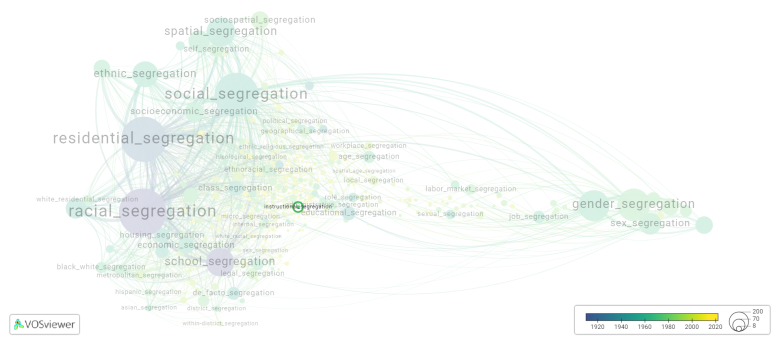Instructional segregation
Date and country of first publication[1]
1983
United States
Definition
Instructional segregation refers to the practice of separating students based on their academic abilities or achievements, and providing them with different instructional experiences or opportunities. This segregation can occur within a classroom or school, or through tracking or ability grouping.
There are several forms of instructional segregation, including:
1. Ability grouping: Students are grouped into different tracks or classes based on their perceived academic abilities or achievement levels. For example, students may be placed in high, middle, or low-level classes for various subjects.
2. Tracking: Students are placed in specific tracks or programs based on their academic performance, typically for the entirety of their school career. This often leads to separate curricula and instructional approaches for each track.
3. Achievement-based segregation: Students are assigned to specific instructional programs or interventions based on their performance on standardized tests or other assessments. This can result in separate interventions or remedial programs for struggling students.
4. Special education programs: Students with disabilities are often placed in separate classrooms or schools to receive specialized instruction tailored to their individual needs.
Critics argue that instructional segregation can have negative consequences for students. For instance:
1. Social and psychological impact: Being labeled as low-achieving or placed in a lower track can have detrimental effects on students' self-esteem and self-confidence. It may lead to stigmatization and further exacerbate educational inequalities.
2. Limited opportunities: Students in lower tracks may be provided with a less rigorous curriculum, fewer resources, or less experienced teachers, which can limit their educational opportunities and future prospects.
3. Lack of diversity: Segregation can lead to racially or socioeconomically homogenous classrooms or schools, minimizing opportunities for students to engage with peers from different backgrounds and limiting their exposure to diverse perspectives.
4. Reinforcing inequalities: Instructional segregation can perpetuate existing achievement gaps among students, as students in higher tracks receive additional resources and support, while those in lower tracks struggle to catch up.
To address instructional segregation, schools and educators can:
1. Implement inclusive practices: Emphasize differentiated instruction within mixed-ability classrooms, allowing all students to experience challenging and supportive instruction tailored to their needs.
2. Provide equitable resources: Ensure that all classrooms have access to high-quality instructional materials, technology, and well-trained teachers, regardless of the students' tracking or ability group.
3. Prioritize teacher professional development: Equip teachers with strategies to provide effective instruction to students with diverse learning needs, allowing them to cater to the various skill levels present within their classrooms.
4. Encourage collaboration and teamwork: Encourage collaboration among teachers of various tracks or abilities to share best practices, resources, and knowledge, fostering a sense of collective responsibility for all students' success.
5. Reevaluate tracking and ability grouping practices: Regularly reassess the effectiveness and equity of tracking or ability grouping policies, considering alternative approaches that promote inclusive education and minimize instructional segregation.
See also
Related segregation forms
Instructional segregation is frequently discussed in the literature with the following segregation forms:
This visualization is based on the study The Multidisciplinary Landscape of Segregation Research.
For the complete network of interrelated segregation forms, please refer to:
References
Notes
- ↑ Date and country of first publication as informed by the Scopus database (December 2023).
At its current state, this definition has been generated by a Large Language Model (LLM) so far without review by an independent researcher or a member of the curating team of segregation experts that keep the Segregation Wiki online. While we strive for accuracy, we cannot guarantee its reliability, completeness and timeliness. Please use this content with caution and verify information as needed. Also, feel free to improve on the definition as you see fit, including the use of references and other informational resources. We value your input in enhancing the quality and accuracy of the definitions of segregation forms collectively offered in the Segregation Wiki ©.
Instructional segregation appears in the following literature
Coleman J.M. (1983). Handicapped labels and instructional segregation: Influences on children's self concepts versus the perceptions of others. Learning Disability Quarterly, 6(1), 3-11. https://doi.org/10.2307/1510857
Coleman J.M., Fults B.A. (1985). Special Class Placement, Level of Intelligence, and the Self Concepts of Gifted Children: A Social Comparison Perspective. Remedial and Special Education, 6(1), 8-10. https://doi.org/10.1177/074193258500600102
Buttaro Jr. A., Gatsambis S., Mulkey L., Steelman L.G. (201). An organizational perspective on the origins of instructional segregation: School composition and use of within class ability grouping in American kindergartens. Teachers College Record, 112(5), 1300-1337. Teachers College, Columbia University.https://doi.org/

